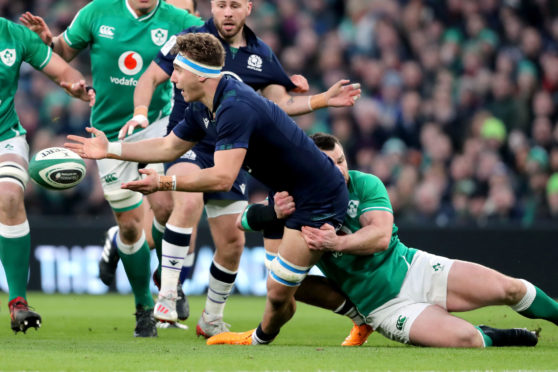Not for the first time, seasoned observers were left confused about what to think of Scotland’s opening Guinness Six Nations Championship performance in the 19-12 defeat to Ireland in Dublin.
It somehow felt like progress, but in reality it was the same old fare – a narrow defeat in Dublin, the fifth in a row in the championship, a dispiriting number of great chances to score tries missed, primarily in that familiar scene of Scotland pounding relentlessly at the Irish line with just millimetres to go but failing to break through the Green Wall.
Stuart Hogg’s howler after 51 minutes, dropping the ball over the line on the one occasion Scotland did stretch Ireland to make an extra man, was merely the most outlandish illustration yet of what has been a perennial problem.
There was still that feeling of progress, which probably came from the fact that expectations can hardly have been lower going into this championship; there were many who feared a thrashing even more severe than the 27-3 humiliation at the Rugby World Cup. Instead, had Scotland scored the two tries they probably deserved on balance of play, they probably could and definitely should have won the game.
In truth, we’re apparently grateful to get back to the frustrations of last year at this time. Scotland have gone forward to get to square one, again, if you like.
The efforts to score against Ireland were very reminiscent of a number of games last year – the home Six Nations matches against the Irish and against Wales, the last 20 minutes of the final World Cup game against Japan.
In those as on Saturday the Scots enjoyed territorial and possession dominance, and even cut through the opposition at times, only to waver when met with a purposeful (and it has to be said, often illegal) defensive front close to the whitewash.
Some seemed to think that the absent Finn Russell would have created the gaps that Scotland failed to find on Saturday. They clearly didn’t even make a cursory examination of those games last year with Russell in place – indeed, Scotland’s other two matches against Ireland in the last 12 months; that’s 240 minutes and change now with just one try scored, by Sam Johnson off a Russell interception.
Adam Hastings didn’t set the pitch on fire but he was decent and made only one specific decision error, and that after he’d been thrown a desperation pass that left him isolated.
The limited progress there was came from the sheer deluge of chances created. Scotland had seven possessions five metres from the Irish line for the total return of six points, and one of those was the bare consolation of an advantage penalty after Hogg’s howler.
Not only, however, were none of those chances turned into five points, the Scots kept allowing Ireland to keep the scoreboard moving along with petty indiscipline – over-keeness at rucks, a stray limb or leg, an obstruction on a player who really didn’t need to be impeded.
Conceding 15 penalties, as Gregor Townsend ruefully admitted afterwards, is not going to win you away a game away from home against a side who’ve lost there just once in five years.
Some Scottish fans – and there was a hint from the squad as well – were upset with referee Mathieu Raynal. He probably was not even-handed at the breakdown where Ireland were allowed to infringe on the margins, but it’s a slippery slope to start believing that referees like Raynal or Romain Poite or anyone else have it in for Scotland.
Still, there were positives. Scotland are nowhere near as bad as we feared, they always had a number of decent players that should have been formed into a better team than they were in Japan.
The scrum had an unexpectedly clear edge on Ireland’s with their two Lions props. Rory Sutherland, for a man who played barely four games this season, was a revelation as Townsend had promised.
Two lineouts were lost, but that’s about par when you play against Peter O’Mahony. Scotland defended Ireland’s much-feared maul better than they’ve done for 20 years, but were unable to get their own going.
Nick Haining, still probably the fourth or fifth choice No 8 if everyone’s fit, played really well. Zander Fagerson is becoming a force all over the park, Jamie Ritchie already is one. And Hamish Watson was again superb, showing how much he was missed after his injury in the World Cup.
The defence, recalibrated with a new “philosophy”, was stretched repeatedly by Gary Ringrose in the first half and after he didn’t return for the second, Ireland’s attack was reduced to chasing Jonathan Sexton’s high bombs.
Hogg’s error overshadowed his best game in a Scotland jersey for well over a year. Sam Johnson also played well at centre, and Sean Maitland totally shut down Ireland’s prolific Jacob Stockdale.
But apart from a few reels showing Hogg’s mistake, a scoreboard reading 19-12, not Scotland’s litany of missed chances, will be remembered out of this game. To change that narrative, Scotland need to start building an attacking strategy that will convert these scoring opportunities, and then we will have every right to expect real progress.

